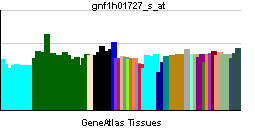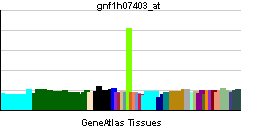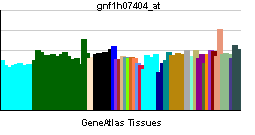GPR98
| G protein-coupled receptor 98 | |||||||||||
|---|---|---|---|---|---|---|---|---|---|---|---|
| Identifiers | |||||||||||
| Symbols | GPR98 ; USH2B; DKFZp761P0710; FEB4; KIAA0686; MASS1; USH2C; VLGR1; VLGR1b | ||||||||||
| External IDs | Template:OMIM5 Template:MGI HomoloGene: 19815 | ||||||||||
| |||||||||||
| RNA expression pattern | |||||||||||
 | |||||||||||
 | |||||||||||
 | |||||||||||
| More reference expression data | |||||||||||
| Orthologs | |||||||||||
| Template:GNF Ortholog box | |||||||||||
| Species | Human | Mouse | |||||||||
| Entrez | n/a | n/a | |||||||||
| Ensembl | n/a | n/a | |||||||||
| UniProt | n/a | n/a | |||||||||
| RefSeq (mRNA) | n/a | n/a | |||||||||
| RefSeq (protein) | n/a | n/a | |||||||||
| Location (UCSC) | n/a | n/a | |||||||||
| PubMed search | n/a | n/a | |||||||||
G protein-coupled receptor 98, also known as GPR98, is a human protein and gene.[1]
This gene encodes a member of the G-protein coupled receptor superfamily. The protein binds calcium and is expressed in the central nervous system. It is also known as very large G-protein coupled receptor 1 because it is 6300 residues long. It contains a C-terminal 7-transmembrane receptor domain, whereas the large N-terminal segment (5900 residues) includes 35 calcium binding Calx-beta domains, and 6 EAR domains. Mutations in this gene are associated with Usher syndrome 2 and familial febrile seizures. Several alternatively spliced transcripts have been described.[1]
References
Further reading
- Nakajima D, Okazaki N, Yamakawa H; et al. (2003). "Construction of expression-ready cDNA clones for KIAA genes: manual curation of 330 KIAA cDNA clones". DNA Res. 9 (3): 99–106. PMID 12168954.
- Staub E, Pérez-Tur J, Siebert R; et al. (2002). "The novel EPTP repeat defines a superfamily of proteins implicated in epileptic disorders". Trends Biochem. Sci. 27 (9): 441–4. PMID 12217514.
- Ishikawa K, Nagase T, Suyama M; et al. (1998). "Prediction of the coding sequences of unidentified human genes. X. The complete sequences of 100 new cDNA clones from brain which can code for large proteins in vitro". DNA Res. 5 (3): 169–76. PMID 9734811.
- Nakayama J, Hamano K, Iwasaki N; et al. (2000). "Significant evidence for linkage of febrile seizures to chromosome 5q14-q15". Hum. Mol. Genet. 9 (1): 87–91. PMID 10587582.
- Pieke-Dahl S, Möller CG, Kelley PM; et al. (2000). "Genetic heterogeneity of Usher syndrome type II: localisation to chromosome 5q". J. Med. Genet. 37 (4): 256–62. PMID 10745043.
- Nikkila H, McMillan DR, Nunez BS; et al. (2001). "Sequence similarities between a novel putative G protein-coupled receptor and Na+/Ca2+ exchangers define a cation binding domain". Mol. Endocrinol. 14 (9): 1351–64. PMID 10976914.
- Wiemann S, Weil B, Wellenreuther R; et al. (2001). "Toward a catalog of human genes and proteins: sequencing and analysis of 500 novel complete protein coding human cDNAs". Genome Res. 11 (3): 422–35. doi:10.1101/gr.154701. PMID 11230166.
- Skradski SL, Clark AM, Jiang H; et al. (2001). "A novel gene causing a mendelian audiogenic mouse epilepsy". Neuron. 31 (4): 537–44. PMID 11545713.
- McMillan DR, Kayes-Wandover KM, Richardson JA, White PC (2002). "Very large G protein-coupled receptor-1, the largest known cell surface protein, is highly expressed in the developing central nervous system". J. Biol. Chem. 277 (1): 785–92. doi:10.1074/jbc.M108929200. PMID 11606593.
- Nagase T, Kikuno R, Ohara O (2002). "Prediction of the coding sequences of unidentified human genes. XXII. The complete sequences of 50 new cDNA clones which code for large proteins". DNA Res. 8 (6): 319–27. PMID 11853319.
- Nakayama J, Fu YH, Clark AM; et al. (2002). "A nonsense mutation of the MASS1 gene in a family with febrile and afebrile seizures". Ann. Neurol. 52 (5): 654–7. doi:10.1002/ana.10347. PMID 12402266.
- Strausberg RL, Feingold EA, Grouse LH; et al. (2003). "Generation and initial analysis of more than 15,000 full-length human and mouse cDNA sequences". Proc. Natl. Acad. Sci. U.S.A. 99 (26): 16899–903. doi:10.1073/pnas.242603899. PMID 12477932.
- Ota T, Suzuki Y, Nishikawa T; et al. (2004). "Complete sequencing and characterization of 21,243 full-length human cDNAs". Nat. Genet. 36 (1): 40–5. doi:10.1038/ng1285. PMID 14702039.
- Weston MD, Luijendijk MW, Humphrey KD; et al. (2004). "Mutations in the VLGR1 gene implicate G-protein signaling in the pathogenesis of Usher syndrome type II". Am. J. Hum. Genet. 74 (2): 357–66. PMID 14740321.
- Bjarnadóttir TK, Fredriksson R, Höglund PJ; et al. (2005). "The human and mouse repertoire of the adhesion family of G-protein-coupled receptors". Genomics. 84 (1): 23–33. doi:10.1016/j.ygeno.2003.12.004. PMID 15203201.
- Fu GK, Wang JT, Yang J; et al. (2005). "Circular rapid amplification of cDNA ends for high-throughput extension cloning of partial genes". Genomics. 84 (1): 205–10. doi:10.1016/j.ygeno.2004.01.011. PMID 15203218.
- Schwartz SB, Aleman TS, Cideciyan AV; et al. (2005). "Disease expression in Usher syndrome caused by VLGR1 gene mutation (USH2C) and comparison with USH2A phenotype". Invest. Ophthalmol. Vis. Sci. 46 (2): 734–43. doi:10.1167/iovs.04-1136. PMID 15671307.
- Kimura K, Wakamatsu A, Suzuki Y; et al. (2006). "Diversification of transcriptional modulation: large-scale identification and characterization of putative alternative promoters of human genes". Genome Res. 16 (1): 55–65. doi:10.1101/gr.4039406. PMID 16344560.
| Stub icon | This membrane protein–related article is a stub. You can help Wikipedia by expanding it. |